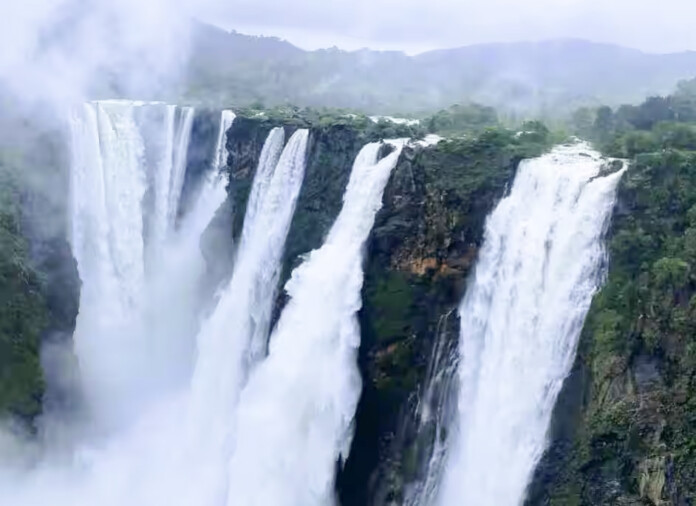India faces a severe water crisis, with some areas plagued by droughts while others suffer from floods exacerbated by climate change. The widespread use of impermeable fossil fuel-based materials in road construction worsens these issues by preventing groundwater recharge. To tackle these challenges, five key approaches are emerging:
1. Large-scale interventions—National River Linking Project (NRLP)
2. Sustainable ecosystem initiatives—Rally for Rivers
3. Nature-based solutions—wetlands, mangroves, parks, etc.
4. Technological innovations—led by startups
5. Behavioral changes—adopted by businesses and individuals
A holistic strategy integrating river linking, afforestation, nature-based solutions, and innovative technologies can help meet India’s water needs both now and in the future. (Current micro-level water initiatives initiated by Center and State are not the focus of this essay)
1. The National River Linking Project: Ambitions and Environmental Concerns
The National River Linking Project (NRLP) is one of India’s most ambitious initiatives, designed to connect 37 rivers through a vast network of canals and dams. The goal is to divert water from surplus rivers to drought-prone areas, thereby addressing water scarcity, boosting agricultural productivity, and mitigating floods. However, the project has drawn criticism from environmentalists who warn that large-scale river diversion could disrupt ecosystems, reduce biodiversity, and harm local communities. People like Rajendra Singh, known as the waterman of India advocate decentralized community based solutions instead of NRLP.
Beyond these concerns lies a lesser-known issue: rivers often follow the flow of underground water, as surface and subsurface water systems are deeply interconnected. Madhukhar Swayambhu, a prominent environmentalist confirms this on platforms such as youtube. Hydrology: An Introduction by Wilfried Brutsaert (2005), also discusses how rivers are often sustained by groundwater discharge during dry periods, reflecting the interconnection between surface and subsurface water systems. Another reference is the article “River-Aquifer Interaction” by Winter et al. (1998), published in Water Resources Research, which explores the dynamics between groundwater and surface water and how they influence each other’s flow patterns.
Artificially disrupting these flows can upset the hydrological balance, leading to unforeseen environmental damage. This perspective aligns with ancient Ayurvedic and Vedic philosophies, which liken the flow of rivers to the circulation of blood in the human body. Disrupting the natural order, or ṛta, as described in Vedic thought, can have serious consequences. A more holistic, nature-aligned approach is essential, rather than the mechanistic interventions often favored in the West. The Ministry of Jal Shakti could benefit from consulting noted Vedic scholars, some of whom already advise the Ministry of Science and Technology on similar issues.
2. Afforestation: Lessons from Rally for Rivers
Unlike the NRLP, the Rally for Rivers initiative offers a holistic water management approach. Launched by Sadhguru Jaggi Vasudev and the Isha Foundation, this campaign emphasizes afforestation and agroforestry as key to stabilizing river flows and preventing soil erosion. A flagship project, Cauvery Calling, aims to plant 2.42 billion trees across the Cauvery River basin, and as of 2024, around 120 million trees have been planted, involving farmers in this ecological mission.
3. Nature-Based Solutions
Trees play a crucial role in the water cycle by absorbing rainwater, reducing surface runoff, and enhancing soil infiltration. Environmental historian Professor Nanditha Krishna, in her book Sacred Plants of India, advocates for large-scale tree restoration across the country. To this end, state governments could develop action plans to establish sacred tree parks in urban areas and create new forests, which could positively influence weather patterns. States like Kerala, need to craft a vision to become the global Ayurvedic capital, it could serve as an inspiring model for others. Nature based solutions are highly cost effective and enhance the quality of water, soil, and air. Such initiatives should be preferred over high capital intensive projects while addressing trade-offs.
Wetlands, among the world’s most productive ecosystems, are vital for biodiversity, carbon storage, groundwater recharge, and coastal protection. India has made significant strides in restoring mangroves through initiatives like Mangroves for the Future (MFF) and the National Action Plan on Climate Change (NAPCC). According to the Forest Survey of India, there was a reported increase of 17 square kilometers in mangrove cover between 2019 and 2021. However, the country has lost approximately 40% of its original mangrove forests due to land reclamation and urban development. Therefore, restoring India’s inland wetlands, coastal mangroves, and other critical ecosystems is essential for long-term environmental sustainability.
Innovative startups like Vaidic Srijan in New Delhi are leveraging Vedic technologies to revitalize dead water bodies. Similarly, China’s Sponge City concept, developed by Turenscape, integrates urban planning with natural water systems, enhancing rainwater absorption, reducing flooding, and replenishing groundwater. This approach has gained global recognition for its role in creating sustainable urban ecosystems. Numerous nature-based solutions worldwide present models that India can emulate. Startups like Vaidic Srijan and Turenscape demonstrate the abundant opportunities available in this field.
4. Technological Innovations to Make India Water-Rich
In my article for Sustainability Next, published on March 7, 2023, titled “Tech Startups Can Make India Water Rich,” I explored how startups are innovating to address water challenges. Innovations include laundromats featuring waterless washer-dryer systems that use liquid CO2, permeable road materials that recharge groundwater, and GPS-enabled robots that detect underground water leaks. Dr. Praveen Kumar’s ocean vapor absorption technology presents an eco-friendly and cost-effective alternative to traditional desalination. Similarly, Rutgers University’s innovation harnesses energy from the ionic difference between freshwater and seawater, offering a cleaner alternative to dam-based energy generation. Additionally, various companies and apartment complexes across India have implemented their own sewage treatment plants (STPs), with treated water utilized for non-potable purposes. Such innovations, including rainwater harvesting, deserve our support.
5. Behavioral Changes: Businesses and Individuals
Adopting lab-grown alternatives for leather, bricks, cement, coffee, cotton, diamonds, and meat can greatly reduce water and land use. For instance, the leather tanning industry is a major source of groundwater pollution. A targeted GST system that incentivizes lab-grown leather could drive sustainable change. Similarly, producing a single plastic water bottle requires more than twice the amount of water used in its contents, and producing a soda can demands even more—highlighting the need for policies that encourage sustainable practices. The government should leverage GST to promote sustainability in various industries, including food production and textiles, where significant water consumption could be reduced by innovations such as liquid CO2 dyeing. My article in Sustainability Next, March 16, 2024, titled “How India Can Leverage Its GST Model for Building a Sustainable Future,” explores in greater detail how GST can foster a circular economy not only in India but globally. The table below shows the water footprint of several everyday products, presenting an opportunity for entrepreneurs to produce these items more efficiently.
Conclusion
India is at a crucial juncture in tackling its water crisis. While large-scale projects like the National River Linking Project (NRLP) propose redistributing water to drought-prone regions, they carry significant environmental risks that necessitate careful consideration of the country’s rich heritage of ancient water management practices. In contrast, initiatives such as Rally for Rivers and decentralized, nature-based solutions offer more sustainable alternatives by focusing on ecosystem restoration. Meanwhile, tech startups globally are advancing innovations that optimize water management, presenting further opportunities for sustainable water use.
In addition, government policies that strategically utilize tools like the GST to incentivize nature-friendly or water-saving products by placing them in a zero-tax tier can drive the widespread behavioral changes needed for water conservation. Such measures could serve as a model for other nations facing similar challenges.
Ultimately, solving India’s water crisis will require strong, coordinated leadership from both central and state governments, as well as active involvement from businesses, civil society, and individuals. These decentralized, community-driven efforts are likely to yield long-term, sustainable solutions for India’s water future, potentially offering more lasting benefits than heavily investing in large-scale projects like the NRLP.
Ram Ramprasad is a passionate advocate for sustainability. He has written many articles on sustainable strategies for well-known publications. Ram has also served as the Global Marketing Director for a leading multinational company in the USA. He holds degrees from Madras University in India and Yale University in the USA.











